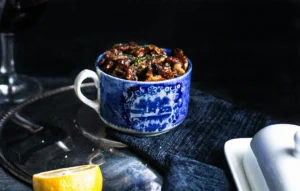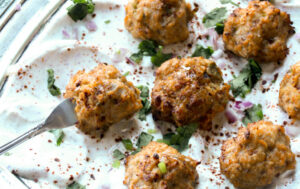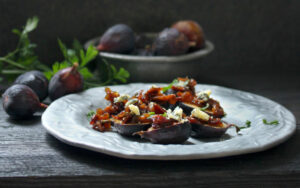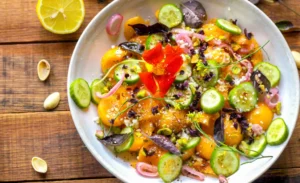When it comes to the artistry of food photography props, there are a cornucopia of styles, mediums, textures, colors, and ages. And with visual-forward social media like Pinterest and Instagram stuffed with food images, it’s never been more popular. (And don’t get me started on the sheer joy I feel every month when I get my favorite food magazines. A cup of coffee and a Bon Appétit, and I’m in pure bliss and ready to pick up my camera!)
Props are the supporting players in the story, but they’re nearly as important as the food that’s lovingly crafted and put on that patinaed plate. Everyone loves a good “buddy movie,” and that’s exactly what they are. They’re the wise friend with the wisecrack at the pivotal time.
Contents
Everything Has a Place
For example, you’ve composed a shot that evokes an elegant kitchen, but in the background, there’s a rustic canning jar filled with black beans or some dishes filled with flowers. That’s cheeky humor, my friends. A little twist of the unexpected.
But there’s nothing wrong with playing it safe, with props either. An elegant table setting with a gorgeous and sumptuous plate of food on white plates sings its own song like a moody jazz standard. Melodic trombone.
Food photography is all about sensory triggers. The melting cheese, the crisp loaf of sourdough, the steam coming off a pot of chicken noodle soup – all these things evoke taste, smell, and memories through food. It’s universal.
Understanding the Role of Props in Food Photography

Props are the reliable narrator of your story. They add interest and explain the location where you’d be dining, give subtle context of the dish, and also set the mood in your food photography.
And there are a multitude of props for food that you can use to set that very vital mood.
Patinaed pans, flowered dinner plates, old crocks, utensils (but none that are too shiny – I’ll circle back to that later), herbs, flowers, rustic boards, white boards, metallic boards, cloth napkins, table cloths, cutting boards (wooden or marble), and a wide array of jars are some of the best props that you’ll come to rely on to show viewers the vision of your story.
In terms of writing, props “show, don’t tell” what the action is in your images.
Photography Evokes Food Memories
For instance, rustic boards always remind me of a cozy little French bakery my friends and I would visit after high school, where we’d frantically load up on ham and cheese croissants before heading off to our after-school jobs.
Dappled light on ceramic bowls reminds me of my grandmother’s kitchen on the farm. We’d sit around in the playful light of the afternoon shelling peas or hulling strawberries while the shadows danced around the produce we’d just picked from the garden.
A piece of parchment paper under a cooling rack filled with baked goods is a photo that makes the viewer feel like home.
While seemingly simple, the right prop can open the door for viewers into the world you’ve created for them using their own memories as a guide.
Essential Food Photography Props to Consider
Before buying the props, you’ll want to have an idea about what kind of world you want to create. Are you shooting for rustic French farmhouse or post-modern punk? Those are the choices you definitely want to make before the food is made and plated.
1. Backgrounds and Surfaces

Wood is versatile and is an easy way to add a little depth to your food photos. Plain barnwood is always phenomenal, light boards can be dressed up any way, and dark boards add a layer of mystery to your photos.
Also, grab that paintbrush, because you can play with colors too! White painted boards are a classic in food photos, but teal is shockingly fun to play with, too. Let your imagination run wild when it comes to the types of food photos you want to take and the best props to get you there.
Marble is a fun background prop for food, and depending on how great your investigative prowess is in stores, you can find it in a variety of colors.
Another fun food prop is fabric because it’s easy to store, and can be used for layering effects, drawing your eyes toward the plate.
Compliment Us!
When it comes to selecting backgrounds, you want them to compliment the food and let the dish shine, and shine in its glory. Neutral-colored backdrops like white, muted yellow, light blue, and a mild green are all great colors for your photos. And, of course our old buddy the rustic board, because I have never found a main subject that doesn’t naturally pop on them.
And don’t be shy about using different types of materials like large tiles or stones. They can really give your photos extra texture.
If you’re leaning more toward the “post punk” rather than the “rustic farmhouse” type of food photo, having sheets of metal around makes an amazing backdrop. The reflections that you get are incredible, especially in sidelight.
Paper is Perfection
Paper is also a great background. One year for my birthday, my husband gave me a variety of faux-newspaper restaurant paper that you find at the bottom of food baskets filled with French fries and onion rings.
“You get me. You really, really get me,” I said as I unwrapped the packs.
That type of paper is amazing for anything that comes out of the deep fryer or air fryer. Just throw it on your shooting space and go to town on it. Your viewers will immediately be transported mentally to a great place – the pub of their choice.
But don’t forget about your pal, the parchment paper! It’s great for shooting in a rimmed sheet pan. (Or for mimicking something on a sheet pan.)
2. Crockery and Cutlery

Bowl (and Plate) Us Over
Pasta bowls are your friend in photos. You love them. You want to metaphorically marry them. So, grab a bunch of them from thrift stores. They give the food some depth without fighting the high sides of an actual bowl. Also, because of their wide rim, you can usually balance a piece of rustic bread on the side.
Minimalist white dinner plates and bowls are great as a standby for food presentation in your food photography. Whether you’re photographing a salad, soup, stew, or just a nice bowl of tzatziki liberally garnished with dill and cucumber, you can’t go wrong with white!
And don’t forget some salad plates, not only for salads, but for rolls and sliced bread. They’re utilitarian. And they’re great props because they don’t take up a ton of space on your shooting table. The same thing applies to dessert plates and pinch bowls. They’re maneuverable.
But white isn’t your only “go-to” option. Grab some softly speckled matte finish bowls and plates from an antique store for added visual interest. Hey, pretty!
Finishes Matter
Let’s talk about finishes for a moment, folks. Matte finishes are your friends. You’d be amazed how much glossy spoons and butter knives can reflect light and also pick up in a reflection in a photo. And matte plates too. So, unless you want to actually be reflected by a utensil in the photo behind the tripod with your hair in a top knot wearing your favorite scruffy tee shirt, reach for the matte spoons and knives. You (and your T-shirt) will thank me later.
3. Dress That Table Up to Add Visual Interest
When it comes to dressing your table, you can’t go wrong with some linen finery. Pale blues, greens, and light-yellow tablecloths, napkins, and textiles create warmth and texture and are some of my favorite props for food photography. Bonus points if you have a steamer rather than an iron to quickly work out unsightly wrinkles. Just sayin’.
You can also utilize cloth to add depth and to create striking compositions, whether working with a busy tablescape or a more stark composition. With linen napkins, either on wood or on a pastel tablecloth, you can create visual interest to soften, luxuriate, or create an unexpected juxtaposition in your food photography.
4. Natural Elements

Speaking of softening a food scene, adding flowers, greenery, and other fresh seasonal elements can create dappled light (depending on the size of the greenery), and they can also bring pops of unexpected color to the food and the dishes on the table.
Also, living plants bring a sense of time and place (and nurturing!) to your photographic setup. My husband is a bonsai enthusiast, and I love to add his handsome tree to photos, especially when creating a lush scene with tropical fruits.
5. Flowers
When you hit the farmers market as a food photographer, don’t forget to eyeball the flowers at a stall! You’d be amazed at how many flowers are edible, such as nasturtiums, violets, and pansies. So, while flowers are amazing as props in a photo shoot, you can also incorporate them into cocktails, salads, and desserts.
So, grab that bouquet of flowers! And for visual interest, throw little bouquets of them in liquid measuring cups. How adorable would that look in your food photography?
Plus, flowers bring a sense of hope, peace, and calm. Isn’t that what we all want?
6. Glassware and Ceramics
Glassware and stemware always add a little something special to your pictures. But, try to find ones that are clear, and thin for maximum visibility. Cut crystal may be visually appealing in real life, but it can work against you when photographing liquid, depending on the angles.
However, there’s a big caveat to that advice! When working with natural sidelight, the refractions of glassware can be stunning on their own. So, play around with the scientific principles of that on a sunny day, and say “thank you” to your middle school science teacher as you manipulate the light.
So, mix and match a bunch of glasses that you’ve picked up at flea markets for your pictures and play, play, play!
7. Make Friends with Your Local Woodworker
Wood adds a warm and natural look to your food setups and dishes, whether it’s wooden cutting boards, bread boards, spoons, salad tongs, salad bowls, plates, or platters. And because wood comes in so many hues, and has its own character with unique grain and the occasional live edge, you can really get into the studio and play with colors and textures. (And height!)
And of course, you can find things online in the world market, but you can also just meander down to your local craft fair and check out the wooden products from your area. Get to know your local woodworkers; they’d probably be thrilled to meet you and to have their gorgeous work in your (equally gorgeous) photos.
Author disclaimer: I’m married to a woodworker who makes a ton of what’s in my prop collection. And I’m not saying you have to go so far as to make one your life partner, but I’ll bet you’ll get some deals on buying props by befriending one!
8. Everything Old is Splendid Again

Hit that secondhand store or antique barn and shop for nostalgia in your props. Vintage teacups, enamelware bowls, patinaed spoons, and other serving utensils are what’s on the shopping list when you’re looking to stock up on your prop collection. They bring a bit of charm, softness, and whimsy to your food photography and recipes.
I’m lucky enough to have inherited an incredible amount of antique dishware from my grandmother. Not because my family was wealthy, but because my grandmother was an avid lawn sale enthusiast throughout her life, and loved beautiful things. (Although beautiful doesn’t mean “perfect.” One of her most cherished serving dishes had a chip in it, which gives an otherwise spectacular plate a unique charm that makes handling it a little less nerve-wracking than if it were perfectly intact.)
Creative Tips for Using Props
This section covers clever ways to bring harmony, texture, and versatility to your food photos and how to guide the viewer’s eye with thoughtful composition, from creating visual balance to choosing props that evoke feeling.
Let’s Harmonize!

One thing that I always try to keep in mind about food photography props is using them with restraint. I mean, it’s pretty easy to get jazzed when you reach for that copper spoon that you’ve been desperately trying to work into a photograph. But the food is the star, the copper spoon is telling a story in the background. Or, harmonizing, as it were.

And harmony isn’t just something you whistle in the background in the studio. It’s what you want in your plating on your shooting table. Keeping the viewer interested by having a focal point like an olive skewered and perfectly balanced on a martini, but having other components in the photo to also hold their interest, like a frosty shaker on its side with a rivulet of liquid gently streaming out. That’s some sweet harmony, folks.
Want to master this visual balance in every shot? Read our step-by-step guide on photographing food.
Let’s Talk Triangles
A great tip for organizing your shooting surface is by utilizing the “prop triangle method.” Basically, imagine a line running from the bottom left to the top right of your shot, and then a line jutting off to the left on the top third of the line, and a line jutting off to the right on the bottom third of the line.
You want the main focus of the viewer’s eye to be gently overlapped by the imaginary main line, and the props to be off to the side and bottom of the frame. Using this technique really helps you to play with negative space and gives your eye space to explore.
Every Prop Has a Story

Props can be as luxe or down-to-earth as you need them to be in your food photography. From the simple metal whisk to a burnished gold soup spoon, your props don’t need to scream, “Look at me!” but they can subtly say, “Check out the time and place I’ve transported you to.”
A whisk in motion, whipping an egg in a bowl, is a dynamic image implying nurturing, comfort, and home. A golden spoon is elegant (nearly to the point of being garish) and screams opulence and high-end dining.
Both prop choices speak volumes.
Textures and Colors
White and grey are both practical colors that can exude a variety of styles. A beach picnic, a warm and rustic farmhouse, an upscale dining experience. More vibrant colors (your reds, dark blues, greens), evoke a sense of urgency and immediacy, like summer produce in a bowl that needs to be celebrated the day it’s picked.
When you think of colors and textures, it’s not just about the background colors in your photography. Color’s helpful for plating, too. For instance, a creamy tomato soup benefits from the contrast of crunchy croutons. Or sesame seeds on the outside of a clear rice paper wrap surrounding soft pink shrimp. It’s a helpful visual interplay to make your food (recipe development and photography) stand out.
And finally, colors really do give people a visceral response. A red and white checkered napkin in a basket screams “picnic with friends” or cozy bistro. A pale blue tablecloth is loaded with rustic charm. All those colors are a short cut to emotion in your audience through photography props.
Versatility is Your Friend

When it comes to photography props that will work in nearly—if not every—situation, you can’t go wrong with canning jars. Now, I know you’re probably thinking, “Whoa, there, crazy lady!” But stay with me.
Those jars are the equivalent of a little black cocktail dress in your photography, because they go with everything. In rustic setups, they can hold fresh or dried flowers, pickles, nuts, grains, pasta, and tall stalks of dried herbs. In a more funky and casual scene, they can hold cocktails, beer, wine, shrimp on skewers, and chicken satay.
See? They’re your friend.
Sourcing Props on a Budget

When it comes to buying food photography props on a budget, you’ve already heard me extol the virtues of canning jars for versatility. Bonus, they’re reasonably priced! (And depending on the size, you get quite a few of them.) Throw a faded ribbon on one, and you have the perfect vase for dried flowers. Buy some black gaffer’s tape and a thin white marker, and you have an insanely delightful DIY label maker that looks phenomenal on the jars.
But, much like my grandmother, I hit up those yard/garage sales. You’ll almost certainly find something fun and/or useful. Two yards of burlap are way more useful than you might think. It’s one of my favorite props. And, of course, you’ll find interesting china, enamelware, glasses, silverware, and gadgets. (Another thing that I found at a yard sale that I treasure is a glass funnel. Rustic and funky!) And of course, you can let your fingers do the walking and shop online too.
And if you’re part of an online photography group, you can always organize a “prop swap,” where you can trade props with your virtual pals.
Here’s What Props Look Like in Action

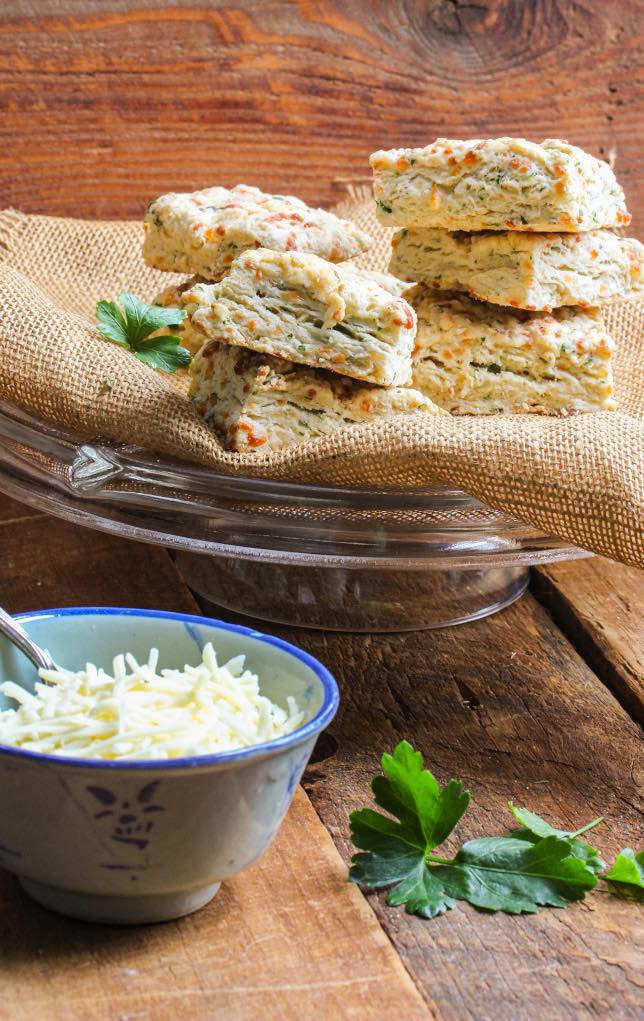
There are times when you walk into the studio after making your recipe and think, “I’ve got this,” but then you don’t. So you shoot and shoot. And shoot. The same setup over and over until … your hand reaches for that one magical photography prop.
In one case, as a recipe developer, I had parsley and cheddar biscuits ready to roll with my new cake stand, cheddar in a beautiful blue bowl contrasting the biscuits, and parsley on the boards to give information about what was in the food and to give it a rustic feel.
Bland. Meh.
Then, I reached for my beloved burlap, and it gave the entire scene a “swoosh” of action and a little whimsy to boot. It wasn’t the obvious choice, but it was a fun one. Thanks, burlap!
Look to the People Around You for Inspiration
And for those times when your photography props are well-meaning, but not helping you out of your photographic conundrum, reach for your favorite photo books, open your phone up, and check out social media, or check out your favorite inspirational recipe websites. The answers are all around you!
And finally, of course, you can find inspiration from people who are experts in their field. Here is a podcast interview with Andrew Scrivani that you’ll find helpful, and dare I say, inspirational toward creating your own personal style.
Take Away
Props are the reliable narrator of your story. They tell the viewer where the action is happening, and they set the tone for your food photos. They’re your buds in the buddy movie of your choice.
Experimenting with props can really help you determine your own personal style. It also wouldn’t hurt to pick up a blank notebook during one of your prop-finding excursions. Use it as a journal to jot down thoughts on the prop combinations that you have found really work for you. You’ll foster your own personal growth, creativity, and keep your handwriting skills in tip-top shape!
Feel free to drop prop ideas and thoughts on setups in the comments of our community forum!




